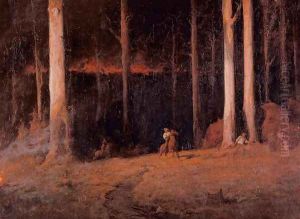John Longstaff Paintings
John Campbell Longstaff was an Australian painter, war artist, and a five-time winner of the Archibald Prize. He was born on March 10, 1861, in Clunes, Victoria, Australia, and showed an early interest in art. Longstaff’s initial career choice was to join his father's mining business, but his artistic talent was evident, leading him to pursue his passion for painting.
In 1882, Longstaff left for Europe to study art after receiving the inaugural National Gallery of Victoria Art School Scholarship. He studied at the Académie Julian in Paris under the tutelage of leading artists such as Gustave Boulanger and Jules Lefebvre. During his time in Paris, Longstaff was greatly influenced by the French academic painting tradition and the works of old masters. He also spent time studying in London before returning to Australia in 1894.
Longstaff quickly established himself as a leading portraitist and figure painter in Australia. His works were noted for their realism and attention to detail, as well as their psychological depth. He earned the Archibald Prize, Australia's most prestigious portrait award, five times between 1925 and 1935. His most famous works include portraits of prominent Australians of his time, such as the opera singer Dame Nellie Melba and the aviator Sir Charles Kingsford Smith.
During World War I, Longstaff served as an official war artist with the Australian Imperial Force. He was stationed in France, where he produced a number of significant works that captured the horrors and heroism of the war. These paintings are now held in the Australian War Memorial collection.
Longstaff's contributions to Australian art were recognized with several honors. He was appointed an official war artist during World War II, and in 1928, he was knighted for his services to art.
John Longstaff died on October 1, 1941, in Melbourne, Australia. His legacy is preserved through his works in various Australian public collections, including the National Gallery of Victoria, the Art Gallery of New South Wales, and the Australian War Memorial. Longstaff is remembered for his technical skill, his ability to capture the character and essence of his subjects, and his role in shaping the course of Australian portraiture and war art.
